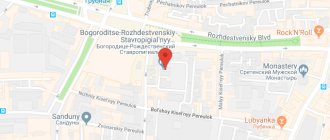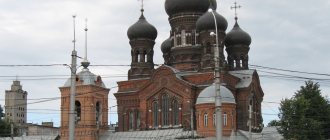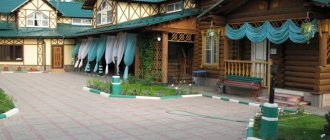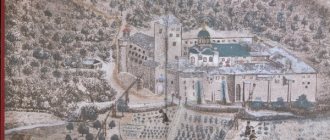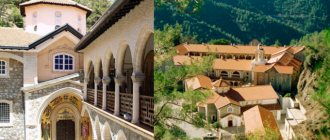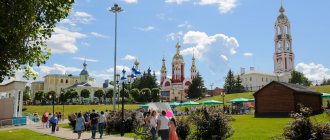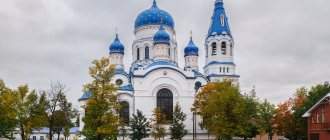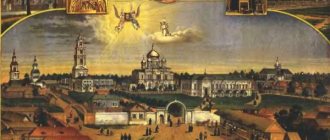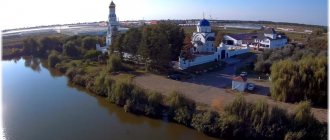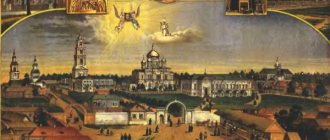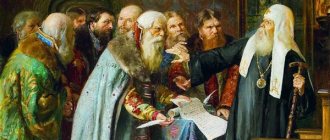Why is this worth attention?
The monastery is an extremely important part of the historical heritage and cultural wealth of our people. In any ancient settlement you can see magnificent and ancient buildings, raising their luxurious golden domes to the skies. Cathedrals and temples impress tourists from neighboring towns and other countries. The monasteries are no less impressive. In total, our Church unites 804 monasteries - such a number inevitably makes you admire. The peculiarity of the monastery is the atmosphere reigning inside. The word appeared in ancient times and comes from the foreign term “alone,” which symbolizes the opportunity to be alone with oneself, one’s faith and one’s thoughts - this is precisely why monasteries were created in ancient times.
One of the oldest Slavic cities is Novgorod. He was extremely important both within the framework of the formation of power, statehood, and for the culture, creativity and religion of his time. The Yuriev Monastery is located here. Historians almost unanimously declare that this particular building is the first monastery in Rus'. Photos of its magnificent walls and interior decoration can be seen in specialized reference books and all city guides. The monastery is truly famous; pilgrims and curious citizens from all over the planet come here from year to year.
“Terrible” 20th century
Remains found on the territory of a monastery cemetery destroyed during Soviet times
In 1918, an anti-Bolshevik rebellion broke out in the monastery; as a result, the brethren were accused of supporting the white movement, and the monastery was closed and placed under the leadership of the military department. Part of the property was transferred to the Murom Museum, and the monastery itself was occupied by a military unit in the 1930s. Barracks for soldiers were built in the fraternal buildings, and a gym was installed in the Transfiguration Cathedral. The necropolis, which was located behind the apses of the Intercession Church and the Spassky Cathedral, was destroyed, and a parade ground was built in its place. The soldiers marched essentially over the bones of people buried here...
Chapel where the ossuary is located
After the return of the Spaso-Preobrazhensky Monastery to the church, the parade ground was dismantled, and a huge number of remains from the desecrated burials were discovered on the site of the former cemetery. For their burial, a chapel-ossuary was built according to the Athonite model. There is an inscription on its wall: “Remember every brother: we were like you, you will be like us.”
How about more details?
One of the first monasteries in Rus' was founded on the banks of the majestic Volkhov River. The initiative to erect a building here dedicated to religious culture, as is known from historical annals, belongs to Yaroslav the Wise. Initially, they erected a small church made of natural wood, and after some time the structure grew, and its purpose changed somewhat - and this is how the Yuriev Monastery appeared. In ancient times, any monastery was not just a place of worship of the gods, but also a fortress that protected ordinary people during enemy invasion. The siege of the walls of a real monastery took a lot of time and very often ended in nothing. It so happened that the monasteries were the first to take the enemy’s blow during the next military conflict.
Along with the protective function, the educational function was significant. It is known that the first monastery in Rus' was founded on the banks of the Volkhov not only for the purpose of protecting the common people. In those days it was a key educational center. Ancient books were kept within the monastery walls, and people were taught here. Traditionally, workshops operated within the walls of the monastery. If the life of ordinary people became especially difficult, ministers shared food and clothing with those in need. Anyone who was in great need could count on the assistance of holy people.
How many priests were there in Russia before the revolution?
According to official church reports, shortly before the revolution, the following worked in these areas: 136 archpriests, 877 priests, 175 deacons and protodeacons (data for 1915) [9], as well as 6 representatives of the highest clergy - bishops, archbishops and metropolitans (data for 1910 G.)[
Interesting materials:
How much load can the socket withstand? How low a temperature can a cactus withstand? What shoes to wear under a down jacket? What shoes to wear with men's jeans? What is the main function of proteins in a cell? What weather do tomatoes like? What weather does Cupid like? What yarn is best to use for a blanket? What seasoning can be added to fish? What profession should a woman get at 40?
More about Yuriev Monastery
This religious building is approximately 4 km away from the modern center of Veliky Novgorod. A unique structure was erected on the banks of the Volkhov. This monastery is revered as one of the oldest Orthodox monuments in all Slavic lands. The name of the monastery was given in memory of the one who ordered its founding: when Yaroslav the Wise was baptized, he was named Yuri. The chronicles that have survived to this day tell about when the first monasteries appeared in Rus'. From them we can conclude that in 1119, on the basis of a previously wooden church, they began to build a cathedral of stone, which was given the name St. George. Then the monastery becomes the spiritual center of the republic. After some time, it turns into the largest and most powerful site in the church's possession.
Secularization, orchestrated by Catherine in the 18th century, was the cause of its decline. Documents telling when the first monasteries appeared in Rus', what fate awaited them subsequently, give an idea of the vicissitudes that befell the religious institution. It is known that a century after Catherine’s reforms, restoration of the unique structure began. This caused the loss of incalculable wealth - ancient frescoes. Only a few have survived to this day.
Yuryev Monastery: vicissitudes of fate
It is known that the first monastery in Rus' was founded near the banks of Volkhv. Despite numerous difficult twists of fate, this object still exists today. Nowadays, this monastery invites only believing men. At the same time, it is a historical, architectural monument that gives modern people an idea of how they lived and worked during the period of Ancient Rus'. The monastery is managed by the diocese of Veliky Novgorod. The facility includes an archimandrite building. A religious school has been opened here.
The first monastery in ancient Rus' was built around St. George's Cathedral. This element is not the only important part of the architectural ensemble. There are two more cathedrals on the monastery lands: Spassky and Holy Cross. One church is open and functioning, named after the Burning Bush. All four places are used for worship. During the war, the temple of the Archangel Michael was destroyed. The restoration work, which started some time ago, has already been completely completed. One of the local attractions is the bell tower, whose height reaches 52 meters. There is a legend that says that the object was originally planned to be built higher. Changes to the plan were made under pressure from Nicholas I. It is believed that he wished that the Moscow bell tower of Ivan the Great remained dominant. It was necessary to remove the middle tier from the project in order to reduce the height of the building.
THE ROLE OF MONASTERIES IN THE CULTURAL LIFE OF Rus'
Orthodox monasteries played a huge role in the cultural, political and economic history of Rus' and Russia. In our country - as, indeed, in other countries of the Christian world - the monasteries of monks have always been not only places of prayerful service to God, but also centers of culture and education; in many periods of Russian history, monasteries had a noticeable impact on the political development of the country and on the economic life of people.
One of these periods was the time of consolidation of Russian lands around Moscow, the time of flourishing of Orthodox art and the rethinking of the cultural tradition that connected Kievan Rus with the Muscovite kingdom, the time of colonization of new lands and the introduction of new peoples to Orthodoxy.
Over the course of the 15th and 16th centuries, the wooded north of the country was covered with a network of large monastic farms, around which the peasant population gradually settled. Thus began the peaceful development of vast spaces. It went simultaneously with extensive educational and missionary activities.
Bishop Stefan of Perm preached along the Northern Dvina among the Komi, for whom he created the alphabet and translated the Gospel. Reverends Sergius and Herman founded the Valaam Monastery of the Transfiguration of the Savior on islands in Lake Ladoga and preached among the Karelian tribes. Reverends Savvaty and Zosima laid the foundation for the largest Solovetsky Transfiguration Monastery in Northern Europe. Saint Cyril created a monastery in the Beloozersky region. Saint Theodoret of Kola baptized the Finnish tribe of Topars and created the alphabet for them. His mission in the middle of the 16th century. continued Saint Tryphon of Pecheneg, who founded a monastery on the northern coast of the Kola Peninsula.
Appeared in the XV-XVI centuries. and many other monasteries. A lot of educational work was carried out in them, books were copied, original schools of icon painting and fresco painting developed.
Icons were painted in monasteries, which, along with frescoes and mosaics, constituted that genre of painting that was allowed by the church and encouraged in every possible way by it.
Outstanding painters of antiquity reflected in icons both religious subjects and their vision of the world around them; they captured in paint not only Christian dogmas, but also their own attitude to pressing problems of our time. Therefore, ancient Russian painting went beyond the narrow framework of church utilitarianism and became an important means of artistic reflection of its era - a phenomenon not only of purely religious life, but also of general cultural life.
XIV – early XV centuries. - This is the heyday of icon painting. It was in it that Russian artists managed to fully express the character of the country and people, and rise to the heights of world culture. The luminaries of icon painting, of course, were Theophanes the Greek, Andrei Rublev and Dionysius. Thanks to their work, the Russian icon became not only the subject of painting, but also of philosophical discussions; it says a lot not only to art historians, but also to social psychologists, and has become an integral part of the life of the Russian people.
Providence extremely rarely orders in such a way that for 150 years, great cultural figures live and create one after another. Russia XIV-XV centuries. in this regard, she was lucky - she had F. Greek, A. Rublev, Dionysius. The first link in this chain was Feofan - a philosopher, scribe, illustrator, and icon painter, who came to Rus' as an already established master, but not frozen in the themes and techniques of writing. Working in Novgorod and Moscow, he managed to create completely different frescoes and icons with equal sophistication. The Greek did not disdain adapting to circumstances: frantic, amazing with irrepressible imagination in Novgorod, he bears little resemblance to the strictly canonical master in Moscow. Only his skill remains unchanged. He did not argue with time and customers, and taught the life and tricks of his profession to Russian artists, including, probably, Andrei Rublev.
Rublev tried to make a revolution in the souls and minds of his viewers. He wanted the icon to become not only an object of cult, endowed with magical powers, but also an object of philosophical, artistic and aesthetic contemplation. Not much is known about the life of Rublev, like many other masters of Ancient Rus'. Almost his entire life path is connected with the Trinity-Sergius and Andronnikov monasteries in Moscow and the Moscow region.
Rublev’s most famous icon, “The Trinity,” caused controversy and doubt during the author’s lifetime. The dogmatic concept of the Trinity - the unity of deity in three persons: God the Father, God the Son and God the Holy Spirit - was abstract and difficult to comprehend. It is no coincidence that it was the doctrine of the Trinity that gave rise to a huge number of heresies in the history of Christianity. Yes, and in Rus' XI-XIII centuries. they preferred to dedicate churches to more real images: the Savior, the Mother of God, and St. Nicholas.
In the symbol of the Trinity, Rublev distinguished not only an abstract dogmatic idea, but also a vital idea for that time about the political and moral unity of the Russian land. In picturesque images he conveyed a religious periphrasis of a completely earthly idea of unity, “unity of equals.” Rublev's approach to the essence and meaning of the icon was so new, and his breakthrough from the canon so decisive, that real fame came to him only in the 20th century. Contemporaries appreciated in him not only a talented painter, but also the holiness of his life. Then the Rublev icons were updated by later authors and disappeared until our century (let’s not forget that 80-100 years after their creation, the icons darkened from the drying oil covering them, and the painting became indistinguishable.
We also know little about the third luminary of icon painting. Dionysius, apparently, was the favorite artist of Ivan III and remained a secular painter without taking monastic vows. In fact, humility and obedience are clearly not inherent in him, which is reflected in his frescoes. And the era was completely different from the times of Grek and Rublev. Moscow triumphed over the Horde and art was instructed to glorify the greatness and glory of the Moscow state. The frescoes of Dionysius do not perhaps achieve the high aspiration and deep expressiveness of the Rublev icons. They are created not for reflection, but for joyful admiration. They are part of the holiday, and not an object of thoughtful contemplation. Dionysius did not become a prophetic predictor, but he is an unsurpassed master and master of color, unusually light and pure tones. With his work, ceremonial, solemn art became leading. Of course, they tried to imitate him, but his followers lacked some small things: measure, harmony, cleanliness - what distinguishes a true master from a diligent artisan.
We know by name only a few monks - icon painters, carvers, writers, architects. The culture of that time was to a certain extent anonymous, which was generally characteristic of the Middle Ages. Humble monks did not always sign their works; lay masters also did not care too much about lifetime or posthumous earthly glory.
This was the era of cathedral creativity. Metropolitan Pitirim of Volokolamsk and Yuryev, our contemporary, wrote about this era in his work “The Experience of the National Spirit” as follows: “The spirit of conciliar work touched all areas of creativity. Following the political gathering of Rus', simultaneously with the growth of economic ties between various parts of the state, a cultural gathering began. It was then that the works of hagiographic literature multiplied, general chronicle collections were created, and the achievements of the largest provincial schools in the field of fine, architectural, musical and singing, and decorative and applied arts began to merge into the all-Russian culture.”
Pages:123next →
Monasteries are communal settlements of believers who live together, withdrawn from the world, while observing a certain charter. The oldest are Buddhist monasteries, which arose in India in the middle of the 1st millennium BC. e. In the Middle Ages, Christian monasteries in Europe were built as fortresses or castles. Since ancient times, Russian Orthodox monasteries have been characterized by a freer, picturesque layout.
Monasteries began to appear in Rus' at the end of the 10th and beginning of the 11th centuries. One of the first - Kiev-Pechersk - was founded by Saint Theodosius in 1051 on the banks of the Dnieper in artificial caves. In 1598 it received the status of a monastery. The Monk Theodosius laid down a strict monastic rule according to the Byzantine model. Until the 16th century, monks were buried here.
Trinity Cathedral is the first stone building of the monastery, erected in 1422-1423 on the site of a wooden church. The temple was built at the expense of Dmitry Donskoy’s son, Prince Yuri of Zvenigorod, “in praise” of Sergius of Radonezh. His remains were transferred here. So the cathedral became one of the first memorial monuments of Moscow Rus'. Sergius tried to spread the veneration of the Holy Trinity as a symbol of the unity of all Rus'. Icon painters Andrei Rublev and Daniil Cherny were invited to create the iconostasis of the Trinity Cathedral.
At the end of the 12th century, instead of the ancient chambers, a refectory was erected - an elegant building, surrounded by a gallery, decorated with columns, ornaments and carved platbands.
Trinity Monastery (XIV century) was founded by the brothers Bartholomew and Stephen on the northern approaches to Moscow. When he was tonsured, Bartholomew received the name Sergius, who began to be called Radonezh.
“Reverend Sergius, with his life, the very possibility of such a life, made the grieving people feel that not everything good in them had yet extinguished and froze... The Russian people of the 14th century recognized this action as a miracle,” wrote historian Vasily Klyuchevsky. During his life, Sergius founded several more monasteries, and his disciples founded up to 40 monasteries in the lands of Rus'.
The Kirillo-Belozersky Monastery was founded in 1397. Legend has it that during a prayer, Archimandrite Kirill of the Simonov Monastery was commanded by the voice of the Mother of God to go to the shore of White Lake and found a monastery there. The monastery developed actively and soon became one of the largest. From the first half of the 16th century, great princes came here on pilgrimage. Ivan the Terrible took monastic vows in this monastery.
Ferapontov Monastery was founded in 1398 by the monk Ferapont, who came to the North with Cyril. From the middle of the 15th century, the Ferapontov Monastery became the center of education for the entire Belozersky region. From the walls of this monastery came a galaxy of famous educators, scribes, and philosophers. Patriarch Nikon, who lived in the monastery from 1666 to 1676, was exiled here.
The Savvino-Storozhevsky Monastery was founded at the end of the 14th century on the site of the Zvenigorod watchtower (hence the name Storozhevsky). During the reign of Alexei Mikhailovich, he used the monastery as a country residence.
Dionysius the Wise - this is what the contemporaries called this famous ancient Russian icon painter. At the end of his life (in 1550), Dionysius was invited to paint the stone Church of the Nativity of the Virgin Mary at the Ferapontov Monastery . Of all the painting ensembles of Ancient Rus' that have come down to us, this is perhaps the only one that has survived almost in its original form.
The Solovetsky Monastery was made of wood, but from the 16th century the monks began construction in stone. At the end of the 17th century, Solovki became an outpost of Russia. In the Solovetsky Monastery, the water-filling dock, dams, and fish cages are amazing. The panorama of the monastery is unfolded along the sea. At the entrance to the Spassky Gate we see the Assumption Church .
The Solovetsky Islands are a nature reserve in the White Sea. The distance from the mainland and the severity of the climate did not prevent the settlement and transformation of this region. Among the many small islands, six stand out - Bolshoi Solovetsky Island, Anzersky Island, Bolshaya and Malaya Muksulma and Bolshoy and Maly Zayatsky. The monastery, founded in the first half of the 15th century by settler monks, brought glory to the archipelago.
Suzdal is one of the first monastic centers of Rus'. There were 16 monasteries here, the most famous being Pokrovsky . It was founded in 1364 by the Suzdal-Nizhny Novgorod prince Andrei Konstantinovich and went down in history as an aristocratic one. Starting from the 16th century, noble women were exiled here: the daughter of Ivan III, nun Alexandra; wife of Vasily III - Solomonia Saburova; daughter of Boris Godunov - Ksenia; the first wife of Peter I, Evdokia Lopukhina, as well as many other women from famous families.
Spassky Monastery was founded in 1352 by the Suzdal prince Konstantin Vasilyevich. In the 16th century it was one of the five largest monasteries in Russia. Its first rector was Euthymius, an associate of Sergius of Radonezh. After the canonization of Euthymius, the monastery received the name of Spaso-Evfimiy. Under the Poles there was a military camp here.
in the Transfiguration Cathedral of the monastery. Next to the altar apses there was a crypt where representatives of this ancient family were buried. The crypt was destroyed by the monks themselves in response to the monastic reform of Catherine II.
The Robe Monastery was founded in 1207. This monastery is the only one that has brought to us the names of its builders - “stone builders” - Suzdal residents Ivan Mamin, Ivan Gryaznov and Andrei Shmakov. The Rizpolozhensky Monastery played a major role in preserving the topography of ancient Suzdal: the oldest Suzdal road passed through the monastery gates, coming from the Kremlin through the settlement along the left bank of the Kamenka River. The double-tented Holy Gate of the monastery, built in 1688, has been preserved.
The Church of the Assumption of the Gethsemane Skete is one of the most interesting buildings in Valaam. It is made in the “Russian style”, which has undergone changes under the influence of the architecture of the Russian North. It stands out for its complex decor.
On March 14, 1613, representatives of the Zemsky Sobor announced to Mikhail Fedorovich, who was in the Ipatiev Monastery, of his election to the kingdom. This was the first tsar of the Romanov dynasty. Associated with his name is the feat of the peasant Ivan Susanin, who led Polish soldiers into the forest who were looking for the way to the monastery in order to take the young king prisoner. At the cost of his life, Susanin saved the young monarch. In 1858, at the request of Emperor Alexander II, the monastery cells of the 16th-17th centuries were rebuilt. The emperor ordered the creation of a family nest for the reigning dynasty here. The reconstruction was carried out in a style stylized in the 16th century.
The Ipatiev Monastery in Kostroma was founded around 1330 by Khan Murza Chet, who converted to Christianity and was the founder of the Godunov family. The Godunovs had a family tomb there. The most ancient part of the monastery - the Old Town - has existed since the day of its foundation.
The Spaso-Preobrazhensky Monastery on Valaam was a major center of religious life. It is believed that it was founded no later than the beginning of the 14th century. The monastery was repeatedly attacked by the Swedes. After the end of the Northern War, according to the Treaty of Nystadt in 1721, Western Karelia was returned to Russia. The buildings of the monastery belong to different eras and styles.
The monastery in Optina Monastery was founded in the 16th century.
Monasteries: which others are known?
Novospassky is one of the first Orthodox monasteries in Rus'. It is located behind Taganka. The building was built during the reign of Ivan the First. From the chronicles it is known that the foundation took place in 1490.
An equally famous monastery is called Borisoglebsky. It was founded during the period when Dmitry Donskoy was in power. The Trinity-Sergius Lavra is extremely popular among ordinary people. It is assumed that this monastery was the largest in the country for some time. The Lavra is extremely important as an element in the development of Christianity in Slavic lands. However, one should not underestimate the importance for the history of the Pskov-Pechersk religious institution. It was created specifically for men. The year of foundation, known from chronicles, is 1473. A distinctive feature is the strongest walls that protected the monastery, and the presence of towers and loopholes, which gave the inhabitants of the holy building the opportunity to defend their independence in the face of even a very powerful enemy.
The whole country knows
Turning to the period of the founding of the first monasteries in Rus', it is worth mentioning the fundamentally important buildings in Suzdal. And today they are revered as incredible wealth, an extremely significant cultural heritage. As some historians say, the one built in Murom can compete with the Yuriev Monastery for the right to be considered the most ancient - it is called Spaso-Preobrazhensky. This monastery was created specifically for men. Even if it is not the oldest, it definitely belongs to the list of the oldest, most important, significant for culture, history and religion. A distinctive feature is the wide variety of icons with atypical subjects preserved from ancient times. To see these beautiful icons, people come to Murom from all over the planet.
New revival of the Spaso-Preobrazhensky Monastery
Monastery garden
In 1995, the Transfiguration Monastery was returned to the Church. Academician Dmitry Likhachev played a major role in the salvation and revival of the monastery, who petitioned Patriarch Alexy II for the revival of the monastery. Hieromonk Kirill (Epifanov) was appointed her deputy. He recalled: “A depressing picture appeared before my eyes. The domes collapsed, the roof was demolished, the barracks were piles of bricks. At first I couldn’t even imagine how to restore all this...”
The icon of the Mother of God “Quick to Hear” came to the rescue again, which for almost 80 years was kept in the storerooms of the Murom Museum and finally returned to the monastery. Restoration proceeded at a rapid pace: brethren gathered at the monastery, benefactors and experienced helpers were found.
Monastery subsidiary farm
Today the Spaso-Preobrazhensky Monastery is one of the most beautiful monasteries in Murom. Currently, on the territory of the monastery there are two large churches, a sacristy, a bell tower, a bathhouse, chapels, a fraternal building, a pilgrimage hotel and a refectory, and an educational building.
Monastic history
The first monasteries of Kievan Rus began to be built after 988, that is, after the official moment the country adopted the Christian faith as the state faith. As historians say, in those days people lived frankly poorly, life was extremely difficult, so everyone tried to find some kind of consolation for themselves, a path to a simpler existence. It was precisely for the needs of such tired, desperate, lost people that the first monasteries appeared. They were created so that people could hope and count on comfort. Anyone could come here. It didn’t matter what class a person belonged to or what he was like. If someone wanted to turn to God, he was allowed into the monastery. It is known that many princes of that time went to monasteries towards the end of their lives. This practice was also common among the boyars. Of the legends, almost any of our compatriots knows about Ilya Muromets. This is a hero who had no equal. Few people know that the real person from whose life story the legend emerged ended his life in the Pechersky Monastery, where he became a monk.
In short, the first monasteries in Rus' appeared by the grace of the wealthy. In those days, these institutions were called ktitorskie. Anyone who had sufficient funds could initiate the construction of a monastery. This is exactly how the first Kyiv religious institutions appeared. They were founded by princes, and boyars made their contribution.
Chapter I. Origins
In the oldest Russian sources, the first mentions of monks and monasteries in Rus' date back only to the era after the baptism of Prince Vladimir; their appearance dates back to the reign of Prince Yaroslav (1019–1054). His contemporary, Hilarion, from 1051, Metropolitan of Kiev, in his famous eulogy dedicated to the memory of Prince Vladimir, “The Sermon on Law and Grace,” which he delivered between 1037 and 1043, while a priest at court,20 said , that already in the time of Vladimir in Kiev “the monasteries on the mountains of Stasha, the Monkmen appeared”21. This contradiction can be explained in two ways: it is likely that the monasteries that Hilarion mentions were not monasteries in the proper sense, but simply Christians lived in separate huts near the church in strict asceticism, gathered together for worship, but did not yet have a monastic charter, did not give monastic vows and did not receive the correct tonsure22, or, another possibility, the compilers of the chronicle, which includes the “Code of 1039”, which has a very strong Grecophile overtones, tended to underestimate the successes in the spread of Christianity in Kievan Rus before the arrival there of Metropolitan Theopemptos ( 1037), probably the first Greek-born hierarch in Kyiv and of Greek origin23.
Under the same year 1037, the ancient Russian chronicler narrates in a solemn style: “And with this, the peasant faith began to be fruitful and expanded, and the monasteries began to multiply more and more, and the monastery began to be. And Yaroslav, loving the church statutes, loved the priests greatly, and was an overflowing monk.”24 And further the chronicler reports that Yaroslav founded two monasteries: St. George (Georgievsky) and St. Iriny (Irininsky convent) are the first regular monasteries in Kyiv. But these were the so-called ktitorsky, or, better said, princely monasteries, for their ktitor was the prince. For Byzantium, such monasteries were common, although not predominant25. From the later history of these monasteries it is clear that the ancient Russian princes used their monastery rights to the monasteries; This was especially true when installing new abbots, that is, we can talk about an exact repetition of the characteristic Byzantine relationship between the ktitor and the monastery he founded. Such monasteries usually received the name after the patron saint of the ktitor (the Christian name of Yaroslav is George, and Irina is the name of the patron saint of his wife); these monasteries later became family monasteries, they received money and other gifts from the ktitors and served as family tombs for them. Almost all monasteries founded in the pre-Mongol era, that is, until the middle of the 13th century, were precisely princely, or ktitorsky, monasteries.
The famous Kyiv cave monastery - the Pechersky Monastery - had a completely different beginning. It arose from the purely ascetic aspirations of individuals from the common people and became famous not for the nobility of its patrons and not for its wealth, but for the love that it gained from its contemporaries thanks to the ascetic exploits of its inhabitants, whose entire life, as the chronicler writes, passed “in abstinence and great repentance, and in prayers with tears.”
Although the Pechersky Monastery very soon acquired national significance and retained this significance and its influence on the spiritual and religious life of the people in later times, much remains unclear in the history of its foundation. Based on various scientific research, this story can be presented as follows26.
The chronicler talks about the founding of the cave monastery in 1051, in connection with the story of the elevation to the metropolitan see of a priest from the church in Berestov (a village southwest of Kyiv, which was in the possession of Yaroslav). His name was Hilarion, and he was, as the chronicle testifies, “a good man, a learned man and a faster.” Life in Berestovo, where the prince usually spent most of his time, was restless and noisy, for the prince’s squad also stayed there, so the priest, striving for spiritual achievements, was forced to look for a secluded place where he could pray away from the bustle. On a wooded hill on the right bank of the Dnieper, south of Kyiv, he dug himself a small cave, which became the place of his ascetic vigils. Yaroslav chose this pious presbyter to the then widowed metropolitan see and ordered the bishops to consecrate him. He was the first metropolitan of Russian origin27. Hilarion's new obedience consumed all his time, and now he could only occasionally come to his cave. But very soon Hilarion had a follower.
This was a hermit who, under the name Anthony, is known as the founder of the Pechersk Monastery. Much in his life remains unclear to us, information about him is fragmentary. His life, written in the 70s or 80s. XI century (but before 1088), which, as A. A. Shakhmatov established, was widely known back in the 13th century, turned out to be lost three centuries later28. This Anthony, a native of the city of Lyubech, near Chernigov, had a strong desire for asceticism; he came to Kyiv, lived there for a short time in Hilarion’s cave, and then went south. Whether he was on Mount Athos, as stated in his life, or in Bulgaria, as M. Priselkov claims (the latter seems more likely to us), is not entirely clear. But this question for the history of the Pechersk Monastery is of only secondary importance, because as the spiritual and religious leader of the monastery and the ascetic mentor of the brethren, it is not Anthony who stands in the foreground, but the abbot of the monastery, St. Feodosius. Anthony belongs to those ascetics who set a shining example with their own lives, but do not have a calling to mentoring and teaching. From the life of St. Theodosius and from the Pechersk Patericon it is clear that Anthony preferred to remain in the shadows and transferred the management of the new monastery into the hands of other brethren. Only the life of Anthony, which was compiled in connection with the very complicated church-political events in Kiev, tells us about the blessing of the Holy Mountain for the founding of the monastery - perhaps with the intention of giving the Pechersky monastery, which grew out of the ascetic aspirations of the Russian environment, the stamp of “Byzantine” Christianity, connecting it with the Holy Mount Athos and presenting its foundation as the initiative of Byzantium. After his return, Anthony, as his life tells, was not satisfied with the structure of life in the Kiev monastery (it could only be the monastery of St. George), again withdrew into solitude - to Hilarion’s cave29. Anthony's piety earned such great reverence among believers that Prince Izyaslav himself, the son and successor of Yaroslav, came to him for a blessing.
Anthony did not remain alone for long. Already between 1054 and 1058. a priest came to him, who in the Pechersk Patericon is known as the Great Nikon (or Nikon the Great). The question of who this Nikon was is interesting and important. I personally agree with the opinion of M. Priselkov that the Great Nikon was none other than Metropolitan Hilarion, who in 1054 or 1055, at the request of Constantinople, was removed from the pulpit and replaced by the Greek Ephraim. At the same time, Hilarion, of course, retained his priestly rank; he appears already as a priest who has accepted the great schema; when he was tonsured into the schema, he, as expected, changed his name Hilarion to Nikon. Now, in the growing monastery, its activities are acquiring a special scope. Being a priest, he, at the request of Anthony, tonsured novices; he, as we will see later, embodied the idea of the national ministry of his monastery; then he leaves the Pechersk monastery and, after a short absence, returns again, becomes abbot and dies, having lived a long, eventful life. Nikon stands at the very center of national and cultural events of the 11th century, since all of them were in one way or another connected with the Pechersk Monastery. He represented that ancient Russian nationally minded monasticism, which opposed both the Greek hierarchy and the interference of the Kyiv princes in the life of the Church30.
If the name of the Great Nikon is associated with the national and cultural flourishing of the Pechersk Monastery, then in the personality of St. We see Theodosius as truly a spiritual mentor and the founder of Russian monasticism. The role of Theodosius is incomparable with the historical role of Anthony. His life, written by the monk of the Pechersk Monastery Nestor in the 80s. The 11th century, at the time when Nikon the Great labored there, depicts Theodosius as an ascetic who embodied the ideal of Christian piety. Nestor was familiar with many hagiographical works of the Eastern Church, and this could have had a certain influence on his narrative about Theodosius, but the appearance of Theodosius emerges from the pages of his life so holistic and alive, so simple and natural, that in Nestor’s narrative one can no longer see only an imitation of hagiographical models . Theodosius came to Anthony in 1058 or slightly earlier. Thanks to the severity of his spiritual exploits, Theodosius took a prominent place among the brethren of the monastery. It is not surprising that four years later he was elected rector (1062). During this time, the number of brethren increased so much that Anthony and Varlaam (the first abbot of the monastery) decided to expand the caves. The number of brethren continued to grow, and Anthony turned to the Kyiv prince Izyaslav with a request to donate the land above the caves to the monastery for the construction of a church. The monks received what they asked, built a wooden church, cells and surrounded the buildings with a wooden fence. In the life of Theodosius, these events are dated to 1062, and Nestor, the compiler of the life, connects the construction of above-ground monastic buildings with the beginning of the abbot of Theodosius. It would be more correct to consider that only the completion of this construction dates back to the reign of Theodosius31. The most important act of Theodosius in the first period of his abbess was the introduction of the cenobitic charter of the Studite monastery. From the life of Theodosius one can learn that he strove for the strictest fulfillment of the brethren’s monastic vows. The works of Theodosius laid the spiritual foundation of the Kiev-Pechersk Monastery and made it an exemplary ancient Russian monastery for two centuries32.
Simultaneously with the flourishing of the Pechersky Monastery, new monasteries appeared in Kyiv and other cities. From the story in the Patericon about the quarrel between the mentors of the Pechersk brethren, Anthony and Nikon, and Prince Izyaslav (over the tonsure of Varlaam and Ephraim, princely warriors), we learn that there was already a monastery of St. Mines. There is no exact information about how and when this monastery arose. It is possible that such a monastery did not exist in Kyiv at all, but that a Bulgarian Monkorizan from the Byzantine or Bulgarian monastery of St. lived there. Miny, who left Kiev with Nikon33. Nikon left the city to avoid the prince's wrath and headed southeast. He came to the shore of the Sea of Azov and stopped in the city of Tmutarakan, where Prince Gleb Rostislavich, the grandson of Prince Yaroslav, ruled (until 1064). In Tmutarakan, which was known to the Byzantines under the name Tamatarkha, Nikon between 1061 and 1067. founded a monastery in honor of the Mother of God and remained there until 1068, until his return to Kiev, to the Pechersk Monastery, where from 1077-78 to 1088 he labored as abbot34.
Dimitrievsky Monastery was founded in Kiev in 1061-62 by Prince Izyaslav. Izyaslav invited the abbot of the Pechersk Monastery to manage it. Izyaslav’s rival in the fight for Kyiv, Prince Vsevolod, in turn also founded a monastery - Mikhailovsky Vydubitsky and in 1070 ordered the construction of a stone church in it. Two years later, two more monasteries arose in Kyiv. Spassky Berestovsky Monastery was probably founded by German, who later became the ruler of Novgorod (1078–1096) - in sources this monastery is often called “Germanich”. Another, the Klovsky Blachernae Monastery, also called “Stephanich”, was founded by Stefan, abbot of the Pechersk Monastery (1074–1077
78) and bishop of Vladimir-Volyn (1090–1094), he existed until the destruction of Kyiv by the Tatars35.
Thus, these decades were a time of rapid monastic construction. From the 11th to the middle of the 13th century. Many other monasteries arose. Golubinsky counts up to 17 monasteries in Kyiv alone36.
In the 11th century Monasteries are also being built outside of Kyiv. We have already mentioned the monastery in Tmutarakan. Monasteries also appeared in Pereyaslavl (1072–1074), in Chernigov (1074), in Suzdal (1096)37. Especially many monasteries were built in Novgorod, where in the XII-XIII centuries. there were also up to 17 monasteries. The most significant among them were Antoniev (1117) and Khutynsky (1192), founded by St. Varlaam Khutynsky. As a rule, these were princely, or monasteries, monasteries. Each prince sought to have a monastery in his capital city, so monasteries were built in the capitals of all principalities - male and female. Bishops served as patrons of some of them. Just until the middle of the 13th century. in Rus' one can count up to 70 monasteries located in cities or their environs38.
Topographically, the monasteries were located on the most important trade and waterways of Ancient Rus', in cities along the Dnieper, in and around Kyiv, in Novgorod and Smolensk. From the middle of the 12th century. monasteries appear in the Rostov-Suzdal land - in Vladimir-on-Klyazma and Suzdal. To the 2nd half of this century we can attribute the first steps in the monastic colonization of the Trans-Volga region, where small hermitages and hermitages were mainly built. Colonization was carried out by immigrants from the Rostov-Suzdal land, who gradually moved towards Vologda. The city of Vologda itself was imported as a settlement near the founded St. Gerasim († 1178) monastery in honor of the Holy Trinity. Further, monastic colonization rushed to the northeast, towards the confluence of the Yug River and the Sukhona39.
The first steps of monastic colonization north of the Volga, in the so-called Trans-Volga region, subsequently, in the 2nd half of the 13th and 14th centuries, grew into a great movement that dotted a vast area with monasteries and deserts from the Volga to the White Sea (Pomerania) and to Ural mountains.
New times and new places
After some time had passed after the appearance of the first monastery in Rus', the Christian religion acquired a much more powerful basis than before. Religion is spreading beyond Kyiv. It is accepted in different parts of Ancient Rus'. Tutoring institutions are absolutely dependent on who allocates money for them. From the chronicles, information about several fairly extensive establishments has reached our days. For example, the first large monastery in Rus' is believed to be Kiev-Pechora. In addition to it, in Kyiv in the 12th century there were 14 more fairly large monasteries. Another 26 were in Novgorod, four in Pskov, three in Chernigov. Chronicles report 14 monasteries that existed in the 12th century in the Vladimir-Suzdal principality. In those days, faith in God was extremely strong. There are a huge number of cases where a prince did not go to war until he received the blessing of the holy father. For this reason, Western peoples began to call Holy Rus', because every city had monasteries and had a temple or several.
The emergence of a church on the site of a cave
Together with his student Theodosius, the monk gathered a group of twelve aspiring priests, and together they organized one of the first churches in Kyiv. The church was small. There were only a couple of icons and prayers. But she quickly became famous throughout Kievan Rus. Over time, people began to come to pray. More and more people began to come to look at the new church. There wasn't enough space. And Anthony decided to create a new cave under the neighboring hill in order to live there. The monk decided that he needed to build a real church. I went to the Prince of Kievan Rus Izyaslav Yaroslavich for permission to build.
Kiev-Pechersk Lavra
According to some historians, it is the first monastery in Rus'. It is believed to have been founded in 1051. If you compare this date with the one indicated above for the building near Volkhov, you will notice that the event happened earlier. The debate over primacy in old age, however, is due to the fact that scientists still doubt the date of construction of the wooden church, which later became the base for the monastery near Novgorod. The initiator of the founding of the Kiev Pechersk Lavra was Yaroslav the Wise. It is believed that a unique religious place, significant for pilgrims to this day, began with a small cave in Berestov, a settlement that the Kyiv princes chose for their summer stay. Hilarion dug the cave so that he could pray in solitude. In the future, this holy father will receive the status of metropolitan. The same cave became the habitat of Anthony, the first Russian hermit.
In ancient Russian, caves were called pechers. This is where the name of one of the first monasteries in Rus' came from. At first, churches, cells - all this was organized in caves. However, already in the 11th century it was possible to erect an above-ground building. It was first built from wood, and after some time it was rebuilt from stone. This is how the Assumption Church appeared. Today it attracts connoisseurs of history, art, cultural heritage, as well as pilgrims from all over the world - it has preserved a huge collection of frescoes and mosaics made in ancient times.
Icon of the Mother of God “Quick to Hear” – the savior of the monastery
In subsequent years, the Spaso-Preobrazhensky Monastery faced many trials. It was plundered during the Time of Troubles, suffered from the church reforms of Peter I and from the policy of secularization of monastic lands pursued by Catherine II. The Spassky Cathedral even had to be closed due to dilapidation: it was dangerous to serve in it, since the walls could collapse at any moment. Liturgy in the monastery could not be celebrated due to the lack of bread and wine.
But even the impoverished monastery did not lose its significance and continued to be famous for its library with a unique collection of ancient written monuments.
And in 1878, a real miracle happened, which began the revival of the monastery. The rector, Archimandrite Anthony (Ilenov), brought from Holy Mount Athos the miraculous icon of the Mother of God “Quick to Hear,” which became the main shrine of the monastery. Many note that the face of the Mother of God changes depending on the events of the day - on holidays she is joyful and smiling, and when tragic events occur, she darkens and is sad.
The icon of the Mother of God “Quick to Hear” saved the monastery from ruin: with its appearance, money and donations suddenly began to flow in. These funds were used to restore the temple and the abbot's building, build a fraternal building, and restore the walls.
Development and growth
Gradually, the first monastery in Rus' is growing and expanding. Caves gradually change their purpose - they become resting places, reliquaries. To visit here, pilgrims come from various remote corners of the world. Theodosius of Pechora and Anthony are revered most of all in the monastery. Enemy raids lead to ruin over and over again, but in the 12th century it was decided to protect the structure with powerful walls so that the holy people could hold the line. In 1240, Batu, however, besieged and defeated the city and took control of the monastery. Soon life will be restored again. In 1598 the monastery received the status of a monastery, and from the end of this century and the beginning of the next it was the center of conflict between Orthodox Catholic clergy. Ultimately, it is the Orthodox who retain the Lavra.
The modern appearance of the magnificent monastery is the result of large-scale construction work that began at the end of the 17th century and ended only in the first half of the next. However, the work did not stop for a long time - the Lavra was completed many times, mainly adhering to the style of classicism.
Monk Anthony and Hilarion's Cave
lampada.in.ua
The name of the founder of the first monastery in Kievan Rus is Anthony. This man was a simple monk. Born and raised in the city of Lyubech. He came to Kyiv to become a priest and lived in one of the Kyiv monasteries. Anthony wanted to find himself a quiet place where he could rest from prayers and retire from all people. One day he came across a hill that was on the banks of the Dnieper. There was a cave under the hill. As it turned out later, this place was called Hilarion’s Cave. Once it was dug by the priest Hilarion in order to live in it, and not in the monastery. Afterwards, Hilarion received the title of Metropolitan of Kyiv and abandoned the cave. Now the monk Anthony began to live there with his students.
Yanchin Monastery
Few people know what the first convent in Rus' was like. It so happens that the topic of female monasticism, in principle, does not attract much public attention. Information that has survived to this day suggests that the very first monastery created for women was Yanchin, built in Kyiv, which was also called Andreevsky-Yanchin. It was erected in honor of Vladimir Monomakh’s sister, nicknamed Yanka in her home circle. Anna Vsevolodovna went down in the history of Orthodoxy as a prominent figure who promoted religion on the territory of Rus'. She was a link with Constantinople, an activist who called on her contemporaries to be more humble and pious. And today historians know that the nun was very active. Was she going to become a nun right away? Historians believe that there were no such intentions. Anna was betrothed to a distant prince, who was forced into a monastery in his own country. The faithful bride, without wasting any time, followed his path. She was not obliged to do this, but in many ways her action changed the fate of Orthodoxy in Rus' - a monastery was opened by the Yankees, and subsequently a girls’ school was opened with it.
Life turned out in such a way that Anna Vsevolodovna had to travel to Constantinople more than once. She brought new ways of life and customs from there to her native lands, studied statutes and manuscripts, and acquired important materials that would later help her in her holy work in her native lands. Arriving home once again, the princess turns to her father with a request to build a nunnery. The brother supports the young girl. In 1086, a decision was made: Vsevolod ordered the construction of a temple named after Andrei, at which a monastery was created. The post of abbess is occupied by the prince's daughter. She decides to keep her pet nickname in the chronicles; the monastery itself was nicknamed Yanchin. He was incredibly handsome. Contemporaries described him as amazing and majestic. It has not survived to this day - a fire consumed the building during Batu’s time.
Already in the first year of the new monastery’s existence, the princess recruited girls to study at the school at the monastery. Girls are taught handicrafts and given writing and singing skills. Sewing skills and various crafts are also taught here. In short, the emphasis is on girls acquiring the most useful skills.
Prince Yaroslav and the Christian faith
Vladimir died in 1015 and was then fifty-four years old.
In 1019, Prince Yaroslav, the son of Vladimir, began to rule. Zealous in the faith, caring for the welfare of his subjects, he, like his father, tried to spread the faith and Christian enlightenment. Under him, the number of dioceses increased significantly, and many churches were built in other main Russian cities. Thus, in the city of Yuryev, Yaroslav built the Church of St. George. The Church of Boris and Gleb was built in Vyshgorod.
Of the churches built under Yaroslav, the most notable were: the Cathedral Church of St. Sophia, the Wisdom of God, in Novgorod and the St. Sophia Church in Kyiv. The first temple in Novgorod burned down, and Yaroslav's son, Prince Vladimir, erected a new St. Sophia Cathedral. It was built and decorated by craftsmen from Greece. It still stands today.
First of all, the Kiev St. Sophia Cathedral, built and decorated by Greek masters, surpassed in wealth and splendor all the churches built at that time in Rus'. It was founded in honor of the victory over the Pechenegs. In addition to the St. Sophia Cathedral, Yaroslav built two churches and monasteries with them. One, Georgievsky, in the name of his angel, and the other Irininsky. It was built in honor of his wife, the daughter of the Swedish king. In addition, under Yaroslav, the Kiev-Pechersk Monastery began to be built; and under him the Novotorzhsky monastery was founded by the Monk Ephraim.
Yaroslav constantly cared about the spread of education among the people. For example, he opened a school in Novgorod, where the children of presbyters and elders studied. He also, on his own behalf, appointed special salaries to the clergy. This was done so that they would gather people around the church more often and teach them the law of God. In addition, he collected many books and founded the first significant library at the Kiev St. Sophia Cathedral.
